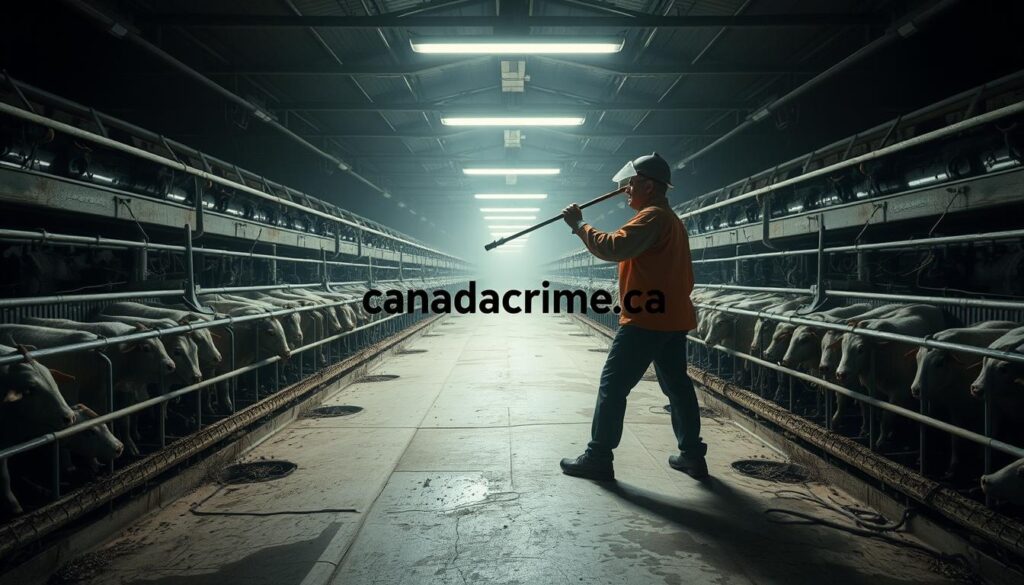Each year, over 45,000 animal abuse cases are investigated in Canada. Experts believe this is only a small portion of actual incidents. Many animals suffer silently, with no one to speak for them.
You have the power to make a difference. The Criminal Code of Canada forbids causing animal suffering through neglect, pain, or injury. This law is your foundation for action when you see mistreatment.
Law enforcement, provincial SPCAs, and agricultural ministries work to enforce these protections. Their success relies on alert citizens who report concerning situations. Your vigilance is crucial.
This guide will help you spot signs of mistreatment and understand legal protections. You’ll learn how to take meaningful steps toward prevention. By knowing how to intervene, you’ll become a vital advocate for animals.
The Reality of Animal Cruelty in Canada
Canada faces big challenges in addressing widespread animal cruelty issues. The mix of laws across provinces creates uneven protection levels. This leaves many animals at risk of abuse and neglect.
To grasp the problem’s scope, we must look at stats and factors allowing animal suffering. The patchwork of laws makes it hard to protect animals consistently across Canada.
Current Statistics and Prevalence
Thousands of animal cruelty cases are reported in Canada yearly. Experts say reported incidents are just a small part of actual occurrences. Provincial SPCAs and humane societies investigate about 45,000 animal cruelty complaints annually.
The Canadian Animal Protection Index shows Canada’s animal welfare laws lag behind other developed nations. This gap is seen in rising cases handled by animal welfare groups, especially for pets and farm animals.
Most Vulnerable Animal Populations
Dogs and cats make up the highest percentage of reported animal cruelty cases. These pets often suffer neglect, abandonment, and abuse in homes.
Farm animals face challenges in industrial agriculture. Intensive confinement practices can cause significant suffering. Lack of federal oversight leaves millions of livestock animals in poor conditions.
Wildlife faces threats from illegal hunting and habitat loss. Limited resources are given for their protection and care.
Regional Hotspots and Concerns
Animal cruelty cases vary across Canada. Rural areas report more neglect cases, especially for farm animals. Urban centers see more pet abuse cases.
Northern communities struggle with limited access to vet care and animal control. Ontario and Quebec report higher numbers of cruelty investigations. This may reflect better reporting systems, not higher actual rates.
British Columbia has strengthened its animal protection laws. It’s created a model that other provinces could follow. Animal welfare is mainly a provincial responsibility, creating uneven protection levels across Canada.
Recognizing Signs of Animal Cruelty
Spotting animal cruelty warning signs helps you act before things get worse. Understanding mistreatment makes you a better advocate for animal welfare. Identifying potential abuse is often the first step to saving an animal from suffering.
Physical Indicators of Abuse and Neglect
Abused animals often show visible signs of distress. Look for untreated wounds, injuries, or sores. Extreme thinness with visible bones suggests severe undernourishment.
Matted, dirty fur or feathers point to neglect. Missing fur patches might signal parasites or stress-induced self-harm. Untreated medical conditions can cause breathing issues, limping, or unusual discharges.

Behavioral Signs of Mistreatment
An animal’s behavior can reveal its treatment history. Excessive fear, like cowering or trembling when approached, may indicate past abuse. Some mistreated animals become unusually aggressive as a defense mechanism.
Abused animals might appear withdrawn or depressed. They may show little interest in normal activities. Watch for repetitive movements like pacing or rocking.
Environmental Red Flags
An animal’s living conditions can reveal potential cruelty, even when the animal isn’t visible.
Inadequate Shelter Conditions
Animals need proper shelter from extreme weather. Be concerned if you see animals outside during severe conditions without protection. Canadian standards like the PAWS Act require suitable shelter for animals.
Unsanitary Living Environments
Buildup of waste and rotting food creates unhealthy living conditions. This can lead to disease spread. Overcrowding is another serious issue that causes stress and fighting among animals.
| Category | Warning Signs | Potential Impact | What To Look For |
|---|---|---|---|
| Physical | Untreated wounds, extreme thinness, matted fur | Pain, infection, malnutrition | Visible injuries, protruding bones, poor coat condition |
| Behavioral | Excessive fear, aggression, withdrawal | Psychological trauma, stress | Cowering, unprovoked attacks, depression |
| Environmental | Inadequate shelter, unsanitary conditions | Exposure, disease, parasites | Lack of protection from elements, accumulated waste |
| Neglect | Lack of food/water, abandonment | Dehydration, starvation | Empty dishes, chained without supervision |
Canadian Laws Against Animal Cruelty
Canada tackles animal cruelty through federal criminal code and provincial laws. This system aims to protect animals nationwide. Knowing these laws helps you advocate for animal welfare and report violations.
Criminal Code Section 445-447
Sections 445-447 of the Criminal Code outlaw animal cruelty. It’s illegal to cause unnecessary pain or neglect animals. The code also bans failing to provide proper food, water, and shelter.
Several agencies enforce these federal laws together. These include local police, SPCAs, and agriculture ministries.
Provincial Animal Protection Acts
Provincial laws often give more detailed animal care standards. They allow inspectors to investigate complaints and rescue animals from danger.

Ontario’s PAWS Act is one of Canada’s strongest animal rights laws. It created a team of inspectors with police-like powers to investigate cruelty cases.
The Act sets clear animal care standards. It imposes fines up to $130,000 and possible jail time for violations.
British Columbia Prevention of Cruelty to Animals Act
BC’s law gives the SPCA broad powers to fight animal cruelty. It defines animal distress and lets special constables seize animals and order better care.
Other Provincial Legislation
Each province has its own animal protection laws. Quebec, Alberta, and Manitoba all have acts to shield animals from cruelty.
Recent Legal Reforms and Amendments
Canada has improved its animal protection laws recently. In 2019, the government expanded the definition of bestiality and increased animal fighting penalties.
Provinces have updated laws to address issues like puppy mills. These changes show Canada’s growing commitment to animal welfare.
Legal Consequences for Animal Cruelty in Canada
Canada’s legal system punishes animal cruelty offenders and protects vulnerable animals. Federal and provincial laws create a framework to address animal cruelty through various penalties and restrictions.
Criminal Penalties and Sentencing
The Criminal Code of Canada imposes serious consequences for animal cruelty offenses. Indictable offenses can lead to prison sentences up to five years. Convicted individuals may also face bans on owning animals.
Sentencing severity depends on the nature of cruelty and the offender’s history. Judges now recognize the link between animal abuse and violent crimes. This has led to stricter sentencing in recent years.
Provincial Fines and Restrictions
Provincial penalties vary across Canada. Ontario has some of the strongest measures through the Provincial Animal Welfare Services Act. In Ontario, animal cruelty offenders can face severe consequences.
- Fines up to $130,000 for first offenses
- Corporate fines reaching $500,000
- Jail sentences up to two years
- Lifetime bans on animal ownership
Other provinces have their own laws with varying penalties. Most include fines, potential imprisonment, and ownership restrictions.

Enforcement Challenges and Limitations
Enforcing animal rights legislation faces significant challenges. Limited resources often result in delayed responses to reports. Rural and remote areas may have minimal coverage, leaving animals vulnerable.
Proving intent in animal cruelty cases can be difficult, especially in neglect situations. Jurisdictional issues between federal and provincial authorities sometimes create enforcement gaps.
Notable Canadian Court Cases
Landmark cases have shaped how courts address animal cruelty. In 2016, a Toronto woman received jail time for hoarding over 100 cats. This set a precedent for penalties in large-scale neglect situations.
A 2019 case saw a British Columbia dog breeder banned from owning animals for life. Authorities found dozens of dogs living in terrible conditions. These cases show courts’ willingness to impose serious consequences for animal mistreatment.
How to Report Animal Cruelty in Your Province
Reporting animal cruelty effectively requires understanding your province’s specific protocols. These vary across Canada but share the goal of protecting vulnerable animals. Knowing who to contact can significantly impact the outcome for distressed animals.
Emergency vs. Non-Emergency Reporting Protocols
Not all animal welfare concerns require the same urgency in response. Call 911 immediately when an animal’s life is in immediate danger, such as:
- An animal attack resulting in serious injury to people or other animals
- A dog or cock fighting ring in progress
- Active animal torture or beating
- An animal left unattended in a hot or cold vehicle
For non-emergency situations, contact your provincial animal welfare agency instead. These include ongoing neglect, inadequate shelter, or concerning living conditions.

Provincial Reporting Agencies and Hotlines
SPCA and Humane Society Contact Information
Each province has dedicated animal welfare organizations that investigate cruelty reports. These agencies employ trained officers with legal authority to intervene in abuse cases.
Animal Welfare Services Contact Information
In Ontario, the Animal Welfare Services (AWS) operates through the Ontario Animal Protection Call Centre. The number is 1-833-9-ANIMAL, available 24/7. Other provinces have similar services with their own reporting systems.
Law Enforcement Reporting Procedures
Police departments across Canada have the authority to enforce animal cruelty laws. Contact your local police non-emergency line when animal welfare agencies are unavailable. Also call when criminal activity is involved.
| Province | Primary Reporting Agency | Contact Number | Hours |
|---|---|---|---|
| Ontario | Animal Welfare Services | 1-833-9-ANIMAL | 24/7 |
| British Columbia | BC SPCA | 1-855-622-7722 | 8am-6pm daily |
| Alberta | Alberta SPCA | 1-800-455-9003 | Mon-Fri, 8am-4:30pm |
| Quebec | MAPAQ | 1-844-264-6289 | Mon-Fri, 8:30am-4:30pm |
Essential Information to Include in Your Report
To ensure your report leads to effective action, provide as much specific information as possible:
- Exact location of the incident (address or detailed description)
- Description of the animals involved (species, breed, color, distinguishing features)
- Nature of the suspected cruelty or neglect
- When you witnessed the situation
- Any history of similar incidents
- Description of the people involved (if applicable)
What Happens After You Report
Once you file a report, provincial inspectors will assess the situation and determine the appropriate response. In Ontario, inspectors work with police officers, First Nations constables, and veterinarians as needed.
The investigation process includes an initial assessment, site visit, and determination of law violations. You may be contacted for more information. Due to privacy rules, you might not receive detailed updates.
Your willingness to report suspected animal abuse is crucial to protecting animal welfare. Even if you’re unsure, it’s better to report and let professionals assess the situation.
Documenting Evidence of Animal Cruelty
Proper documentation is crucial for building a strong case against animal abusers. Your evidence can make or break an intervention. Knowing how to document within legal boundaries is essential.
Safe and Legal Documentation Methods
Respect property boundaries when gathering evidence. In Canada, recording from public areas is generally legal. Entering private property without permission is trespassing.
Privacy laws vary by province. Familiarize yourself with local regulations before documenting suspected abuse. If possible, obtain permission from property owners before recording.
For shared properties like apartments, only document what’s visible from common areas.

Types of Evidence That Support Investigations
Photographic and Video Evidence
Clear, well-lit photos and videos provide compelling evidence of animal rights violations. When documenting:
- Capture wide shots showing the entire scene and close-ups of specific concerns
- Include timestamps and location indicators when possible
- Record continuously rather than in short clips to provide context
- Avoid editing or altering images in any way
Written Records and Testimonies
Maintain detailed written records of your observations, including:
- Dates, times, and locations
- Weather conditions (especially in neglect cases)
- Descriptions of animals and their condition
- Names and contact information of other witnesses
Protecting Yourself While Gathering Evidence
Your safety must remain the priority. Never confront suspected abusers directly. This could escalate the situation dangerously.
Maintain a safe distance when documenting. If possible, bring a companion. If you feel unsafe, withdraw immediately and contact authorities.
Ontario’s Animal Protection Call Centre can connect you with trained local authorities. They can investigate safely and effectively.
Industries Associated with Animal Cruelty in Canada
Animal suffering in Canada extends beyond individual cases to entire industries. Exploitation has become systematized in many commercial sectors. Your consumer choices can significantly impact the reduction of animal cruelty.
Factory Farming Practices and Regulations
Factory farming is a major source of animal suffering in Canada. Animals are confined in cramped conditions, unable to express normal behaviors. Factory farming prioritizes efficiency over welfare, as seen in battery cages and gestation crates.
The Canadian Food Inspection Agency (CFIA) mainly covers transport and slaughter. On-farm conditions remain largely unmonitored by federal authorities. This regulatory gap leaves animals vulnerable to poor living conditions.

Puppy Mills and Unethical Breeding Operations
Puppy mills operate across Canada, especially in Quebec and Ontario. These facilities mass-produce puppies for profit with little regard for animal welfare. Dogs live in filthy conditions and receive inadequate veterinary care.
Female dogs are treated as breeding machines, often having multiple litters without rest. Many puppies are sold through pet stores or online marketplaces. This makes it hard for buyers to see the conditions where their pets were raised.
Entertainment and Tourism Exploitation
Animals in entertainment face unique welfare challenges in Canada. Roadside zoos and marine mammal facilities often keep animals in substandard conditions. These operations frequently lack proper accreditation and may acquire animals through questionable channels.
Some provinces have strengthened regulations, but enforcement remains inconsistent. Animals in film productions have more oversight. However, traveling shows and small exhibitions often operate with minimal scrutiny.
Laboratory Testing and Research
Canada uses about 4 million animals annually in research and testing. The Canadian Council on Animal Care provides guidelines, but these are largely voluntary. Animals in labs may experience pain and distress, often without relief.
Progress has been made in developing alternatives to animal testing. Yet, many industries still rely heavily on animal models despite available alternatives.
Wildlife Trafficking and Exploitation
Canada serves as both a source and transit country for wildlife trafficking. Native species like black bears face exploitation through illegal trade networks. The illegal wildlife trade threatens biodiversity and often involves extreme cruelty.
| Industry | Primary Welfare Concerns | Regulatory Body | Enforcement Level |
|---|---|---|---|
| Factory Farming | Confinement, mutilations, selective breeding | CFIA (transport/slaughter only) | Low to moderate |
| Puppy Mills | Overcrowding, lack of veterinary care, overbreeding | Provincial authorities | Very low |
| Entertainment | Unnatural behaviors, inadequate housing, training methods | Provincial wildlife departments | Inconsistent |
| Laboratory Testing | Pain, distress, confinement | Canadian Council on Animal Care | Moderate (voluntary) |
| Wildlife Trafficking | Poaching, inhumane transport, habitat destruction | Environment Canada, CBSA | Moderate |
Taking Action Against Animal Cruelty
There are many ways to fight animal cruelty in your community and across Canada. You can address immediate needs and systemic issues. Your involvement can range from local efforts to supporting established organizations.
Community Intervention Strategies
Start by creating solutions in your neighborhood. Set up a community watchdog program to spot animal neglect or abuse. These programs often include neighborhood walks and phone trees for quick response.
Community education is key for prevention. Organize info sessions at schools or libraries about responsible pet ownership. Teach people about animal welfare standards to raise awareness.
Supporting Canadian Animal Welfare Organizations
National Organizations
Groups like Humane Canada work to create systemic change nationwide. They develop programs for companion animals, farmed animals, and wildlife protection. Your support can make a big difference.
You can donate money, volunteer your skills, or join their initiatives. Every contribution helps these organizations continue their vital work.

Local organizations provide direct care to animals in need. These groups often operate with limited resources. They rely heavily on community support to function effectively.
You can help by fostering animals or donating supplies. Offering transportation or volunteering at adoption events are also great ways to contribute.
Advocacy and Public Awareness Campaigns
Changing public perception is crucial for long-term animal welfare improvements. You can spread animal rights messages through various channels. Your voice can make a real impact.
“Never doubt that a small group of thoughtful, committed citizens can change the world; indeed, it’s the only thing that ever has.”
Organize awareness events or create educational social media content. Partner with local businesses to promote animal welfare. These efforts help shift attitudes about how we treat animals.
Political Engagement and Legislative Reform
Laws protecting animals only improve when citizens demand change. Your voice matters in the political process. Speak up for those who can’t.
Contact your representatives about animal welfare laws. Attend public consultations on animal-related policies. Support candidates with strong animal protection platforms. Join advocacy days organized by animal welfare groups.
By engaging at multiple levels, you help end animal cruelty in Canada. Address immediate suffering and work towards systemic reforms. Together, we can prevent future abuse and create lasting change.
Prevention Strategies for Animal Cruelty
Comprehensive prevention strategies are key to fighting animal cruelty across Canada. These proactive approaches address issues before they worsen. You can help create a safer environment for animals in your community.
Educational Initiatives and Resources
Education is crucial in preventing animal cruelty. Many resources in Canada spread awareness and promote responsible animal care.
- School programs that teach children about animal welfare and compassionate treatment
- Community workshops offering guidance on proper pet care and recognizing signs of distress
- Online training modules for animal caregivers and professionals
These tools help build respect for animals from a young age. By supporting these initiatives, you contribute to long-term ways to prevent cruelty to animals. Your participation spreads knowledge and awareness.
Community Watchdog Programs
Vigilant citizen networks can greatly reduce animal cruelty incidents. These programs train neighbors to spot signs of animal neglect or abuse.
They work with local authorities and animal protection services. This ensures quick responses to concerning situations.

Supporting Ethical Businesses and Practices
Your shopping choices directly impact animal welfare. Support businesses with strong ethical standards to help reduce animal cruelty.
Look for legitimate certifications on products. Research companies’ animal welfare policies before buying cosmetics, clothing, and food.
Addressing Root Causes of Animal Abuse
Animal cruelty often links to other social issues. These include domestic violence, mental health challenges, and economic hardship.
Supporting comprehensive social services indirectly helps prevent animal cruelty. Programs addressing poverty, mental health, and domestic violence create safer environments for all.
Ontario has set higher care standards for specific animal groups. These include outdoor dogs, marine mammals, wildlife in captivity, and primates. These regulations model appropriate treatment across species.
Resources for Rescued Animals Across Canada
Canada’s rescued animals benefit from a network of emergency shelters, rehabilitation programs, and adoption services. These resources ensure affected animals receive proper care to recover and thrive. Reporting animal cruelty helps connect animals with the support they need.
Emergency Shelters and Sanctuaries
Emergency shelters across Canada offer immediate refuge for rescued animals. These facilities provide specialized care for different species, from pets to farm animals and wildlife. Organizations like the SPCA maintain shelters to address urgent medical needs and psychological trauma.
Wildlife rehabilitation centers focus on injured or orphaned wild animals. These sanctuaries offer safe spaces for recovery, playing a crucial role in animal welfare.

Rehabilitation Programs by Province
Canadian provinces offer unique rehabilitation programs for regional needs. British Columbia specializes in marine mammal rescue. Alberta focuses on animals affected by oil and gas development.
Ontario and Quebec have large rehabilitation networks for abused farm animals. Maritime provinces design programs for wildlife impacted by coastal industries and climate change.
Adoption Networks and Foster Programs
Adoption networks help recovered animals find permanent homes. You can support these efforts by:
- Becoming a foster parent for animals awaiting adoption
- Volunteering at adoption events
- Sharing adoption listings on social media
- Adopting rescued animals yourself
Financial Support for Animal Medical Care
Medical care for rescued animals often requires significant funding. Humane Canada offers several ways to contribute financially:
- Monthly giving programs that provide consistent support
- Securities and mutual funds donations for tax-efficient giving
- Women for Humane Canada leadership circle for dedicated advocates
- Memorial or tribute donations to honor loved ones
Many veterinary clinics offer charitable services or discounted rates for rescued animals. Emergency medical funds cover costly treatments for animals saved from cruelty. This ensures animal rights extend to proper healthcare.
Conclusion: Your Role in Creating a Cruelty-Free Canada
Your actions matter in the fight against animal cruelty. Awareness is the first step toward change. Look for signs of neglect and question product practices.
Animal welfare depends on citizens recognizing their power to intervene. Report suspected abuse through proper channels. You become the voice for animals who can’t speak for themselves.
Your consumer choices send powerful messages. Support ethical businesses and avoid those linked to animal rights violations. This creates market pressure for industry-wide improvements.
Find your unique contribution based on your skills and resources. You might excel at documentation or volunteering at rescue organizations. Perhaps you can foster recovering animals or advocate for legislative reform.
Stronger animal protection in Canada requires persistent effort from all angles. Recent legal reforms have made progress. However, many vulnerable animals still need champions.
Small steps today join you with thousands of committed Canadians. Together, we can ensure humane treatment for all animals. Your role in creating a cruelty-free Canada begins now.

